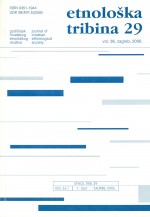Zamisli Velimira Deželića st. o osnivanju Etnografskog muzeja u Zagrebu
Velimir Deželić Sr's Idea of Founding an Ethnograhic Museum in Zagreb. An unhappy chronology
Author(s): Aleksandra MurajSubject(s): Cultural history, Museology & Heritage Studies, Cultural Anthropology / Ethnology, 19th Century, Pre-WW I & WW I (1900 -1919)
Published by: Hrvatsko etnološko društvo
Keywords: Ethnographic Museum in Zagreb; Velimir Deželić Sr; the history of Croatian ethnology;
Summary/Abstract: His multiple activities made Velimir Deželić Sr (Zagreb, 1864-1941) one of the most compelling personalities in Croatian culture in the first half of the 20th century. He was the director of the University Library in Zagreb (1911-1920), editor of the literary journal Prosvjeta (1889-1911), vice-president of the Croatian Catholic Society of St Jerome (1921-1941) and a lexicographer, as well as being the author of numerous literary works and literary and theater criticism. As co-founder of the Society of the „Brethren of the Croatian Dragon“ (1905) he was also the prime mover and a participant in numerous activities aimed at preservation and revival of Croatian cultural heritage, including his initiation of the idea of founding an Ethnographic Museum in Zagreb. He believed that the organisation of an ethnographic exhibition as the foundation of the future museum would fittingly mark the commemoration of the one thousandth anniversary of the founding of the Kingdom of Croatia. He supported the idea that the exhibition present all the traditional phenomena from the material, social and spiritual culture of the entire Croatian ethnic domain. The idea of constructing a magnificent museum building for such a purpose was not what he had in mind; rather, he considered it would be much more appropriate for the museum to consist of a series of pavilions in the form, in fact, of authentic village houses and outbuildings. Deželić's proposals fell on deaf ears at that time, receiving a similar reception to countless efforts made to the same end prior to his initiative. In other words, proposals for founding a national museum that would also hold ethnographic exhibits had been put forward as early as at the time of the Croatian National Revival, at the prompting of Ljudevit Gaj in 1829. New suggestions were noted at the time of holding the great Slavic Ethnographic Exhibition in Moscow in 1867, while not even Iso Kršnjavi managed to implement these intentions as an adjunct to the founding of the Museum of Arts and Crafts in 1880. Although the end of the 19th century was also marked by the creation of many collections of ethnographic material, these items finished up in other existing Zagreb museums (along with the Museum of Arts and Crafts, in the National, School, and Trade & Crafts Museum). This unhappy chronicle of unsuccessful striving continued into the 20th century. These efforts included one of the most developed concepts, that of Antun Jiroušek from 1910, similar in the mode of planned implementation to Deželić's put forward somewhat later. It was only under the circumstances of the new State and political situation on conclusion of World War I, and thanks primarily to the expansive ethnographic collection of Salomon Berger, that the Ethnographic Museum in Zagreb finally became a reality in 1919.
Journal: Etnološka tribina : Godišnjak Hrvatskog etnološkog društva
- Issue Year: 36/2006
- Issue No: 29
- Page Range: 7-21
- Page Count: 15
- Language: Croatian

